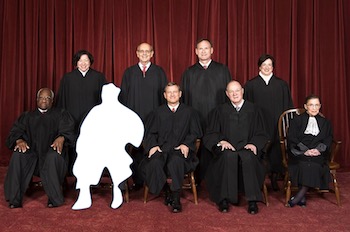 For those who don’t follow the American judicial drama unfolding during a presidential election year (we have more to offer the world than Donald Trump!), here is the abridged version: Justice Antonin Scalia, arguably one of the most outspoken conservatives on the bench, passed away earlier this month rather suddenly. As the US Constitution provides, President Obama vowed to rapidly nominate a candidate as a replacement, who would almost certainly be more liberal than Scalia. Not surprisingly, the US Senate, whose constitutional duty is to provide “advice and consent” to the President regarding the nominee –a veto right in reality, has come out this week stating it would not even entertain such nomination hearings under the Obama presidency, let alone confirm any nominee.
For those who don’t follow the American judicial drama unfolding during a presidential election year (we have more to offer the world than Donald Trump!), here is the abridged version: Justice Antonin Scalia, arguably one of the most outspoken conservatives on the bench, passed away earlier this month rather suddenly. As the US Constitution provides, President Obama vowed to rapidly nominate a candidate as a replacement, who would almost certainly be more liberal than Scalia. Not surprisingly, the US Senate, whose constitutional duty is to provide “advice and consent” to the President regarding the nominee –a veto right in reality, has come out this week stating it would not even entertain such nomination hearings under the Obama presidency, let alone confirm any nominee.
This essentially means that most cases to be heard by the US Supreme Court until the end of June (and possibly extending to next fall session as well), will result in decisions issued by an 8-justice bench, which might lead to several 4-4 ties. This would ultimately make the lower Appellate Courts the temporary de facto Supreme Court, as a tie normally maintains the lower court decision.
Several of the cases on the Supreme Court’s current docket are related to intellectual property matters, and since there is often an assumption that the Court takes a case when it may not agree with the Appeal Court decision, it is important to understand just what the absence of Justice Scalia will mean to patent owners until a new judge is appointed.
Justice Scalia never hid the fact that patent law was his “blind spot”. He also admitted to often taking his cues on IP issues from his colleague Justice Ginsberg. On a Court that has not been kind to patent owners these past years, Justice Scalia, who never feared a bit of controversy, was generally considered as a “staunch defender of patent rights” (as long as they were valid) and viewed them, rightly so, as property. On the other hand, he is also the first Supreme Court Justice to refer explicitly to “patent trolls” (in the Commil case), and not in a good way… He also famously called out the Federal Circuit jurisprudence on obviousness as “gobbledygook.” Google it; it is not exactly a compliment!
During his thirty-year long tenure as an Associate Justice, Scalia actually wrote for the majority 9 separate IP-related decisions, which, according to Stanford Professor Lisa Larrimore Ouellette, were unanimous 85% of the time. However, he authored no majority opinion, concurrence, or dissent in any patent case in the last five years and his lone written contribution to the court’s patent cases was not agreeing to three footnotes in Octane Fitness, LLC. v. Icon Health & Fitness, Inc.! Because of this and given the overall consensus on the bench around IP matters, most pundits do not predict that the absence of Justice Scalia will have a significant short term impact overall. But is this really the fact?
The Supreme Court has already agreed to hear three patent cases during the current term (which run until the late June recess), while many others are awaiting writ of certiorari review to see if the Court will pick them up for its fall session.
- Halo Electronics, Inc. v. Pulse Electronics, Inc., No. 14-1513 (enhanced damages) (February 23 Oral Arguments linked with Stryker)
- Stryker Corporation, et al. v. Zimmer, Inc., 14-1520 (enhanced damages) (linked to Halo)
- Cuozzo Speed Technologies, LLC v. Michelle K. Lee, No. 15-446 (Broadest Reasonable Interpretation claim construction in IPRs v. different standard in court cases; institution decisions unreviewable)
It is expected that the Halo-Stryker cases will see a reversal of the narrow definition of the Federal Circuit as to what behavior triggers enhanced (aka “treble”) damages. Even the U.S. government – which intervened in the case – agreed at the hearing that the “objectively reasonable defense” (the current test for willful infringement) “creates an arbitrary loophole that allows some of the most egregious infringers to escape enhanced damages.” Indeed, based on the Court’s comments during the oral arguments earlier this week, the bench seemed suspicious of the lower court approach, but did not seem to readily know how to replace it.
Patent owners will probably chalk this up as a win, as a lower bar for enhanced damages may bring serial infringers to the negotiation table rather than risk facing significant damages. Combined with the recent settlement between CMU and Marvel whereby the semiconductor company agreed to abandon its appeal and to pay the university $750 million for the infringement of one of its patents, a reversal of the Halo-Stryker doctrine will provide a long awaited push to the pendulum into an opposite direction.
The situation in Cuozzo is a bit messier, because the court cannot simply unify the standard of proof for patent validity before the PTAB and the courts without some corresponding change in the regulations, as patentees should no longer have the ability to modify their claims during an Inter Partes Review if the PTAB is using the court’s standard. Here, the author of the popular PatentlyO blog and well respected professor Dennis Crouch predicts that the Supreme Court will be quite divided and thinks that Justice Scalia, a clear supporter of “bright rules” and simplicity, would probably have sided with a unified standard and reversed the current Federal Circuit stance. We will never know how he would have “voted”, but a split 4-4 decision would retain the current approach and likely continue the carnage that has taken place at the PTAB those past year with an exceedingly high rate of invalidation for all types of patents.
The next months will be telling and it would be great if President Obama could nominate someone who has a bit more patent background, as none of the current justices really do. In this regard, one of the candidate names floated recently was that of Lucy H. Koh, the first Asian-American district judge in the Northern District of California, who oversaw the string of patent cases between Apple and Samsung and recently issued an – extremely rare – injunction against Samsung, albeit at the request of the Federal Circuit. She could very well be fast tracked to the nomination process as her candidacy is perceived as less politically symbolic than other potential nominees.
A US Supreme Court justice who actually understands patents. What’s not to like?

![[IPWatchdog Logo]](https://ipwatchdog.com/wp-content/themes/IPWatchdog%20-%202023/assets/images/temp/logo-small@2x.png)

![[Advertisement]](https://ipwatchdog.com/wp-content/uploads/2024/04/Artificial-Intelligence-2024-REPLAY-sidebar-700x500-corrected.jpg)
![[Advertisement]](https://ipwatchdog.com/wp-content/uploads/2024/04/UnitedLex-May-2-2024-sidebar-700x500-1.jpg)
![[Advertisement]](https://ipwatchdog.com/wp-content/uploads/2024/04/Patent-Litigation-Masters-2024-sidebar-700x500-1.jpg)

![[Advertisement]](https://ipwatchdog.com/wp-content/uploads/2021/12/WEBINAR-336-x-280-px.png)
![[Advertisement]](https://ipwatchdog.com/wp-content/uploads/2021/12/2021-Patent-Practice-on-Demand-recorded-Feb-2021-336-x-280.jpg)
![[Advertisement]](https://ipwatchdog.com/wp-content/uploads/2021/12/Ad-4-The-Invent-Patent-System™.png)






Join the Discussion
4 comments so far.
Anon
February 26, 2016 05:16 pmThere are several other Justices in the high 70’s/80’s.range…
Ginsburg – almost 83 (on March 15)
Kennedy – 80 this July
Breyer – 77
Gene Quinn
February 26, 2016 05:00 pmCK-
I think Louis’ pointing to Koh was rather prophetic. She no doubt has a lot of fans in certain circles. Depending upon who wins the next election she could easily become an appealing member of any short list of candidates. I doubt that she will get the nod this time having been tapped for the 9th Circuit.
Whoever President Obama appoints well may be a sacrificial lamb, so this is probably much better for Koh.
-Gene
B
February 26, 2016 04:25 pm‘He also famously called out the Federal Circuit jurisprudence on obviousness as “gobbledygook.” Google it; it is not exactly a compliment!’
I am a big Scalia fan, but KSR was gobbledygook times two. Alice Corp. set a new standard whereby conventional methods to measure gobbledygook became obsolete and new gobbledygook measurement techniques and even a logarithmic gobbledygook scale were needed.
CK
February 26, 2016 02:39 pmLucy Koh was nominated to be a circuit judge in the 9th cir. yesterday. The first step of “fast-track” you think?